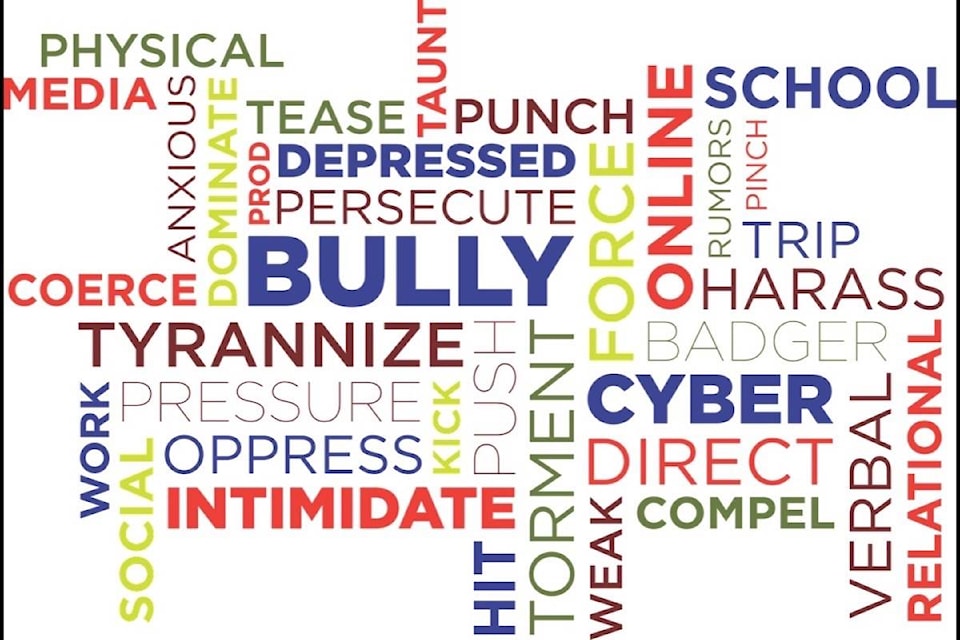Bullying in the school system has not gone away with COVID-19, so School District 83 (North Okanagan-Shuswap) is using new strategies to tackle the problem.
Carol-Ann Leidloff, director of instruction for inclusive education at School District 83, said bullying seems to have followed students home when classes went online in the spring and summer of 2020. Help with the issue was also extended to students.
Leidloff and other B.C. educators were given information based on the monitoring of worrisome online activity by young people. She said online evidence of behaviours like drug use and suicide ideation increased in July and August 2020 but went back down when students returned to the support structure of in-person classes in September.
According to Leidloff, the pandemic has not been kind to the most vulnerable children and families. COVID-19 and the ensuing public health orders put increased pressure on many families. Leidloff said challenges at home, particularly domestic abuse, play out in a variety of ways at school, with bullying behaviours showing up among its symptoms.
Leidloff also linked pressures created by the pandemic with a rise in a variety of risky and harmful behaviours such as the use of drugs and unhealthy sexual activity.
When classes did return to schools it changed the way teachers covered course material, as well as the way anti-bullying information was presented. The lack of large school assemblies led anti-bullying information to be distributed class by class, and online tools have grown in importance.
One of the online anti-bullying resources available to school staff and students is the provincial government’s ERASE campaign. ERASE is an acronym standing for expect, respect, and a safe education. The campaign advises students to report if they are being bullied and to stand up for others. ERASE also maintains an online reporting tool which can allow students to tell a safe-schools coordinator about bullying or other issues that are troubling them or their classmates. Reports can be filed anonymously if the student prefers.
With many in-person social and recreational activities cancelled or limited due to the pandemic, social media use has increased; Leidloff said an increase in online conflict and cyberbullying has followed. Because of this, anti-bullying efforts have included work on helping kids use social media and other online information in a healthy way.
Some strategies are valuable regardless of whether the bullying takes place in person or online. Leidloff said efforts are made to help students identify the difference between bullying and conflict, and also to resolve conflict early before it leads to bullying. She said bullying usually has a power imbalance, the intent to hurt, and is repeated over time. Conflicts are among peers with an equal power dynamic.
She added that an emphasis is also placed on getting kids who are being bullied to turn to teachers, friends, or other supportive adults at the school.
According to Leidloff, awareness campaigns like Pink Shirt Day are beneficial for getting people talking about bullying, but one day isn’t enough. She said efforts are made year round to create a welcoming culture that does not tolerate bullying and encourages students who are experiencing it to report it.
She added that bullying is symptomatic of a need for further mental health supports for young people. Although School District 83 has a range of programs in place for students from Kindergarten to Grade 12, more can always be done to prevent bullying.
According to a 2018 student health survey conducted across the Thompson, Cariboo, and Shuswap region, 56 per cent of students reported that they had been bullied at or on the way to school in the past year. Of those, 41 per cent said they had been deliberately excluded, 40 per cent had been teased to the point they felt extremely uncomfortable, and 10 per cent had been physically attacked.
Sixteen per cent of students (nine per cent of males and 22 per cent of females) reported being cyberbullied in the past. Six per cent of students reported missing school due to bullying.
editorial@accjournal.ca
Like us on Facebook and follow us on Twitter
